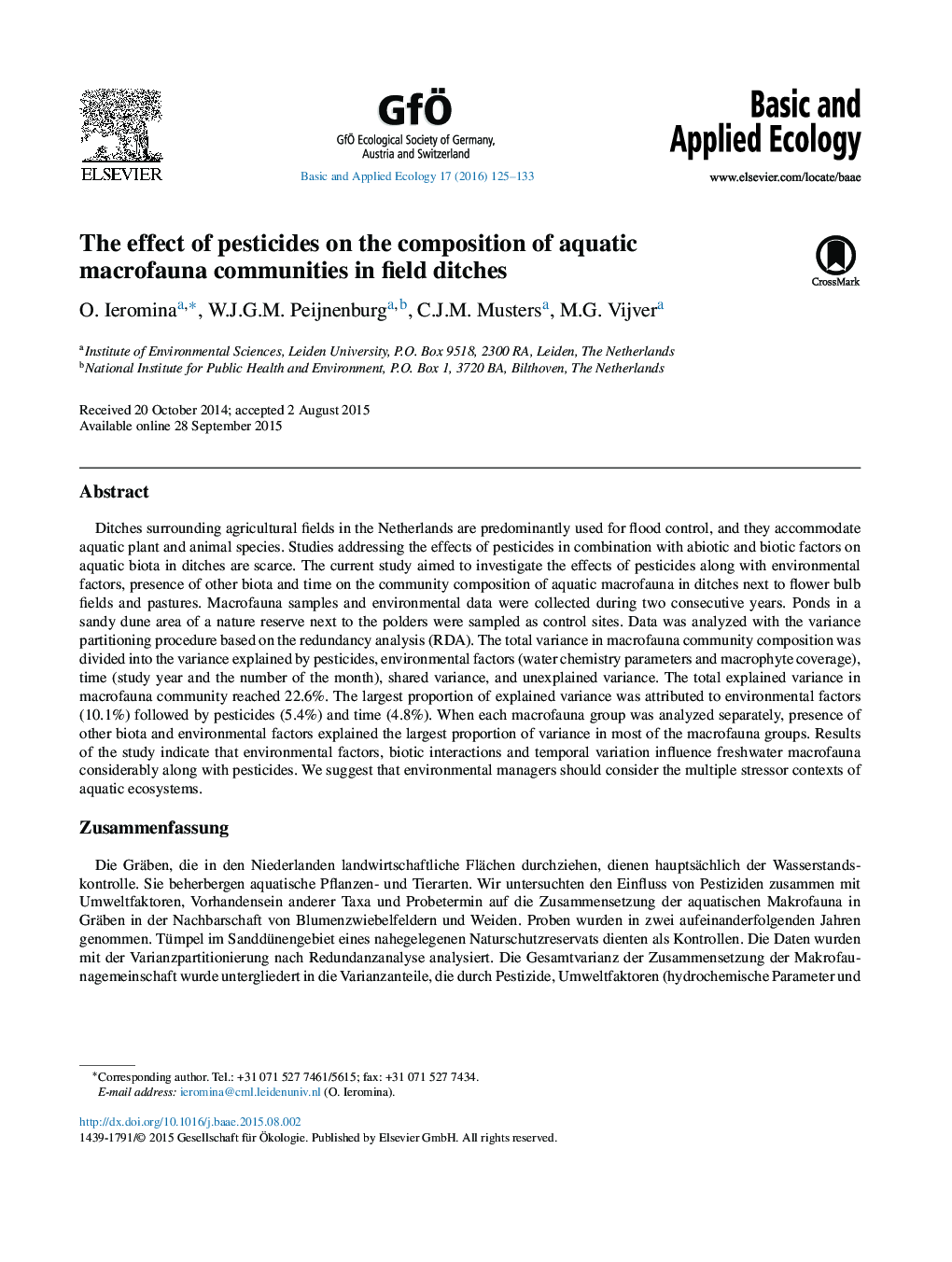| کد مقاله | کد نشریه | سال انتشار | مقاله انگلیسی | نسخه تمام متن |
|---|---|---|---|---|
| 4383967 | 1304379 | 2016 | 9 صفحه PDF | دانلود رایگان |
Ditches surrounding agricultural fields in the Netherlands are predominantly used for flood control, and they accommodate aquatic plant and animal species. Studies addressing the effects of pesticides in combination with abiotic and biotic factors on aquatic biota in ditches are scarce. The current study aimed to investigate the effects of pesticides along with environmental factors, presence of other biota and time on the community composition of aquatic macrofauna in ditches next to flower bulb fields and pastures. Macrofauna samples and environmental data were collected during two consecutive years. Ponds in a sandy dune area of a nature reserve next to the polders were sampled as control sites. Data was analyzed with the variance partitioning procedure based on the redundancy analysis (RDA). The total variance in macrofauna community composition was divided into the variance explained by pesticides, environmental factors (water chemistry parameters and macrophyte coverage), time (study year and the number of the month), shared variance, and unexplained variance. The total explained variance in macrofauna community reached 22.6%. The largest proportion of explained variance was attributed to environmental factors (10.1%) followed by pesticides (5.4%) and time (4.8%). When each macrofauna group was analyzed separately, presence of other biota and environmental factors explained the largest proportion of variance in most of the macrofauna groups. Results of the study indicate that environmental factors, biotic interactions and temporal variation influence freshwater macrofauna considerably along with pesticides. We suggest that environmental managers should consider the multiple stressor contexts of aquatic ecosystems.
ZusammenfassungDie Gräben, die in den Niederlanden landwirtschaftliche Flächen durchziehen, dienen hauptsächlich der Wasserstandskontrolle. Sie beherbergen aquatische Pflanzen- und Tierarten. Wir untersuchten den Einfluss von Pestiziden zusammen mit Umweltfaktoren, Vorhandensein anderer Taxa und Probetermin auf die Zusammensetzung der aquatischen Makrofauna in Gräben in der Nachbarschaft von Blumenzwiebelfeldern und Weiden. Proben wurden in zwei aufeinanderfolgenden Jahren genommen. Tümpel im Sanddünengebiet eines nahegelegenen Naturschutzreservats dienten als Kontrollen. Die Daten wurden mit der Varianzpartitionierung nach Redundanzanalyse analysiert. Die Gesamtvarianz der Zusammensetzung der Makrofaunagemeinschaft wurde untergliedert in die Varianzanteile, die durch Pestizide, Umweltfaktoren (hydrochemische Parameter und Makrophytenbestand) und Termin (Untersuchungsjahr und Monat) erklärt wurden, sowie gemeinsame Varianz und unerklärte Varianz. Die insgesamt erklärte Varianz der Makrofaunagemeinschaft erreichte 22,6%. Die größten erklärten Anteile entfielen auf Umweltfaktoren (10,1%), Pestizide (5,4%) und Termin (4,8%). Wenn die Makrofaunagruppen getrennt analysiert wurden, erklärten Umweltfaktoren und die Anwesenheit anderer Taxa in den meisten Fällen die größten Varianzanteile. Unsere Ergebnisse zeigen, dass Umweltfaktoren, biotische Interaktionen und zeitliche Variation die Süßwassermakrofauna erheblich neben den Pestiziden beeinflussen. Das Umweltmanagement sollte die vielfältigen Zusammenhänge von Stressoren in aquatischen Ökosystemen berücksichtigen.
Journal: Basic and Applied Ecology - Volume 17, Issue 2, March 2016, Pages 125–133
